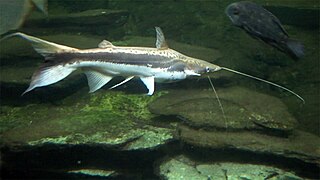
The redtail catfish, Phractocephalus hemioliopterus, is a pimelodid (long-whiskered) catfish. In Venezuela, it is known as cajaro, in Guyana, it is known as a banana catfish, and in Brazil, it is known as pirarara, stemming from the Tupi language words pirá and arara. It is the only extant species of the genus Phractocephalus. This fish is common in the aquarium trade, although its massive adult size makes it unsuitable for all but the largest aquariums. They feed on fish, crustaceans and fallen fruits.

Acanthicus is a genus of large, South American suckermouth armored catfishes native to the Amazon and Orinoco basins, and possibly in Guyana. The name Acanthicus is derived from the Greek, akanthikos meaning thorny, spiny. Fish of this genus are known as lyre-tail plecos. These species are found in large rivers, primarily in areas with a rocky bottom and a moderate or strong current.

Aspidoras is a genus of catfishes of the family Callichthyidae from Brazil.
Apistoloricaria is a genus of armored catfishes native to South America.

Hypancistrus is a genus of loricariid catfish originating from the Amazon basin in South America. Unlike many of the other Loricariids, however, some Hypancistrus species are more carnivorous and enjoy meat in their diet. Hypancistrus species are popular aquarium fish, including such popular fish as the zebra pleco and Queen Arabesque pleco.

Sorubim is a small genus of long-whiskered catfish native to tropical South America. A number of characteristics allows the differentiation of each species in the genus. Sorubim species are important food fish in South America and are highly significant to fisheries of some areas; however, harvests of these fish are not identified as much as other, more popular food fishes such as Colossoma, Arapaima, and Brachyplatystoma. Some species of this family are popular aquarium fish.

Peckoltia is a genus of small South American armored suckermouth catfishes. Many of these fish are popular aquarium fish.
Exastilithoxus is a small genus of suckermouth armored catfish native to South America.

Leiarius is a genus of long-whiskered catfishes native to South America. Most of the genus' species are found in the aquarium hobby as ornamental fish.
Paralithoxus is a genus of suckermouth armored catfishes native to tropical South America.

Pseudacanthicus is a genus of medium to large-sized suckermouth armored catfishes native to South America, where found in the Amazon and Orinoco basins, as well as rivers of the Guianas. They are primarily found in fast-flowing waters, sometimes relatively deep. They are sometimes kept in aquariums.

Synodontis nigrita, known as the false upside down catfish, is a species of upside-down catfish that occurs widely in northern Africa. It was first described by French zoologist Achille Valenciennes in 1840. The type specimen is in the Muséum National d' Histoire Naturelle de Paris.
Synodontis polli, known as Poll's synodontis, is a species of upside-down catfish endemic to the Democratic Republic of the Congo, Burundi, Zambia, and Tanzania, where it is only known from Lake Tanganyika. It was first described by Belgian ichthyologist Jean-Pierre Gosse in 1982, from specimens collected at multiple points along the shore of Lake Tanganyika.

Synodontis petricola, known as the cuckoo catfish, or the pygmy leopard catfish, is a species of upside-down catfish endemic to Burundi, Zambia, the Democratic Republic of the Congo, and Tanzania where it is only known from Lake Tanganyika. It was first described by Belgian ichthyologist Hubert Matthes in 1959. The species name "petricola" is derived from a combination of the Latin petra, meaning stone or rock, and the Latin cola, meaning inhabitant. This refers to the rocky environment where this species is found.
Leporacanthicus triactis is a species of armored catfish native to Colombia and Venezuela, where it is found in the upper Orinoco River basin. This species grows to a length of 24.7 centimetres (9.7 in) SL.

Synodontis macrostigma, known as the largespot squeaker, is a species of upside-down catfish that is native to Angola, Botswana, Namibia, South Africa and Zambia where it is found in the Cunene, Okavango, upper Zambezi and Kafue River systems. It was first described by British-Belgian zoologist George Albert Boulenger in 1911, from specimens collected in the Okovango River, Botswana, by R. B. Woosnam. The species name macrostigma is derived from the Greek word makros, meaning "large", and the Greek word stigma, meaning "mark" or "spot" and refers to the large spots on the sides of the fish.

Synodontis obesus, known as the Coas synodontis, is a species of upside-down catfish that is native to the coastal drainages of Cameroon, Ghana, Nigeria and Togo. It was first described by British-Belgian zoologist George Albert Boulenger in 1898. The species name obesus is derived from the Latin word obesus, meaning "fat".
Synodontis tanganyicae is a species of upside-down catfish endemic to the Democratic Republic of the Congo, Zambia, and Tanzania, where it is only known from Lake Tanganyika. It was first described by Russian-American ichthyologist Nikolai Andreyevich Borodin in 1936, from specimens collected at Kasaga, in what is now the Democratic Republic of the Congo. The species name tanganyicae comes from the habitat of the species, Lake Tanganyika.

Synodontis melanostictus is a species of upside-down catfish endemic to Lake Tanganyika and its tributaries. It has been found in Zambia, the Democratic Republic of the Congo, and Burundi. It was first described by British-Belgian zoologist George Albert Boulenger in 1906, based upon a specimen from the Lofubu River. The species name "melanostictus" is derived from a combination of the Greek melano, meaning black, and the Greek stiktos, meaning punctured or spotted. This refers to the black spotted pattern that occurs on the body of this species.













